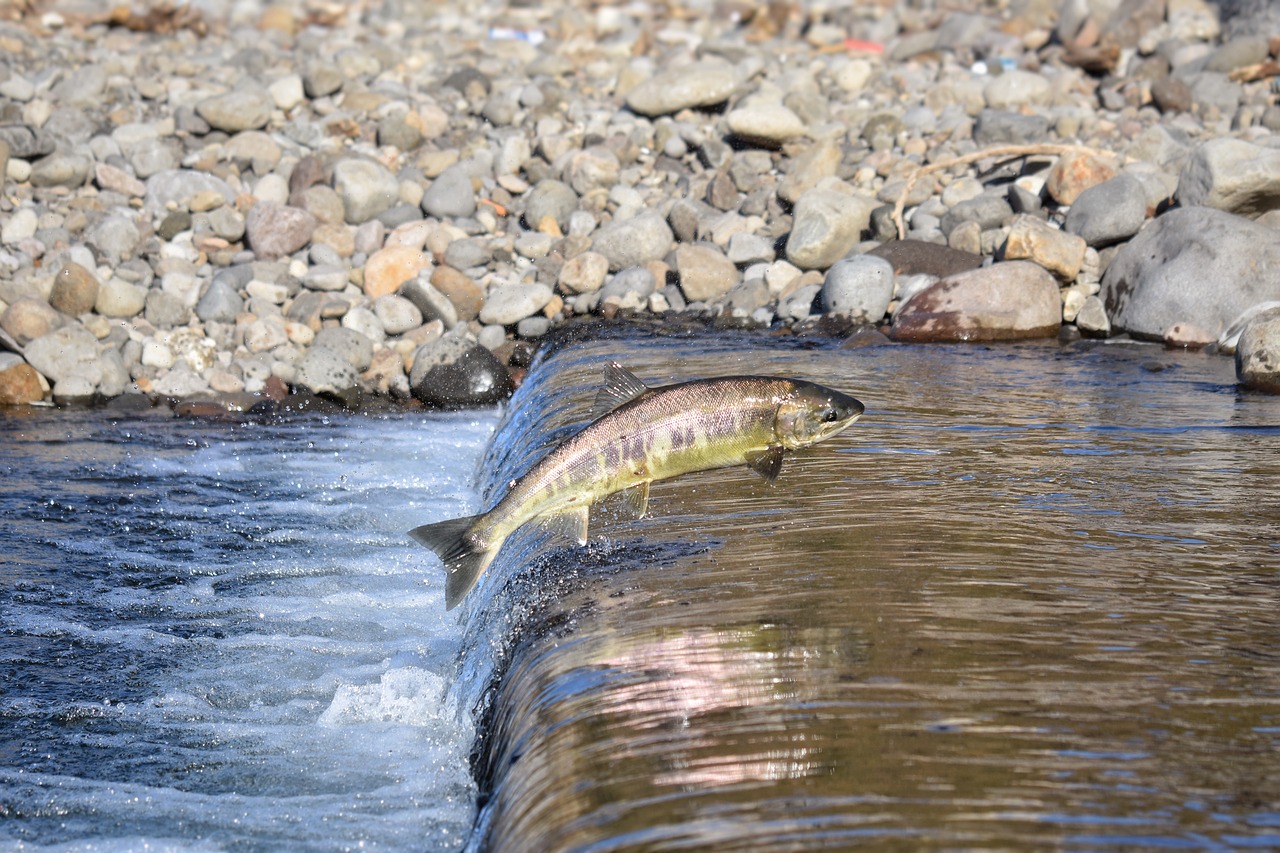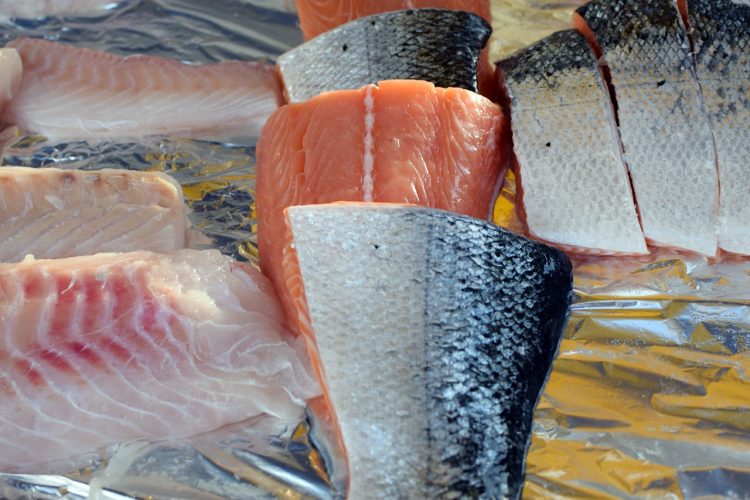
When it comes to sharing your favorite foods with your furry friend, it’s essential to know what is safe and what could potentially be harmful. Salmon, a popular fish and protein source known for its health benefits in humans, often brings up questions about the safety and benefits of its parts for dogs. Specifically, many pet parents wonder: Can dogs eat salmon skin? This article explores the benefits, risks, and best practices for feeding salmon skin to dogs.
Table of Contents
Is Salmon Skin Good for Dogs?
While salmon skin can be beneficial, there are several risks that pet owners should be aware of:
- Preparation Method: Raw salmon skin can carry parasites that are harmful to dogs. Cooking the salmon skin thoroughly is crucial to kill any parasites and prevent diseases like salmon poisoning disease, which is fatal if untreated.
- Seasonings and Additives: Cooked salmon skin should be plain, without any added oils, butter, salt, garlic, or onions, as these can be harmful, and some even toxic, to dogs. Seasonings and additives can also lead to gastrointestinal upset or other health issues.
- Source of Salmon: The source of the salmon can affect whether it’s safe for your dog. Wild salmon may have fewer pollutants than farm-raised, but it’s also more likely to carry parasites. Ensuring the salmon is sourced responsibly and tested for pollutants like mercury is essential.
- Allergies: Some dogs might be allergic to salmon. Introducing salmon skin into your dog’s diet should be done gradually, and watching for any signs of an allergic reaction is important.
- Caloric Intake: Salmon skin is high in fat, which can contribute to obesity in dogs if fed in large amounts. It should be given only as a small part of your dog’s diet.
How Much Salmon Skin Can Dogs Eat
When considering adding salmon skin to your dog’s diet, it’s crucial to ensure the amount is appropriate for their size to prevent any digestive issues or imbalances in their diet. In general, treats like salmon skin should not take up more than 10% of your dogs daily caloric intake.
Thus, here are some size-specific guidelines on how much salmon skin dogs can likely eat:
- Extra Small Dogs (<10 lbs): About less than 1 teaspoon of cooked salmon skin, served infrequently.
- Small Dogs (10-25 lbs): 1 teaspoon of cooked salmon skin, in moderation.
- Medium Dogs (25-60 lbs): Up to about 1.5 teaspoons of cooked salmon skin, infrequently
- Large Dogs (60-100 lbs): 2 teaspoons of cooked salmon skin, served in moderation.
- Giant Dogs (100+ lbs): Up to about 3 teaspoons of cooked salmon skin, once in a while.
Remember to always ensure that the salmon skin is thoroughly cooked to kill any parasites and to make it safer for consumption. If feeding salmon skin, only offer it plain, without any additives, as these can be harmful to dogs. Keep an eye on your dog for any signs of allergies or digestive issues after consuming salmon skin. Always discuss with your veterinarian before introducing new foods into your dog’s diet, especially if your dog has specific health conditions or dietary needs.
Nutritional Benefits of Salmon Skin
Salmon skin can be a healthy treat for dogs, provided it is prepared correctly. Here are some of the nutritional benefits:
- Omega-3 Fatty Acids: Salmon skin is rich in omega-3 fatty acids, which can help reduce inflammation and support your dog’s immune system. These fatty acids are also beneficial for a dog’s skin and coat, promoting a shiny and healthy appearance.
- Proteins: Like the rest of the salmon, its skin is high in protein, which is crucial for muscle development and energy levels in dogs.
- Vitamins and Minerals: Salmon skin contains vitamins such as B vitamins and minerals like potassium and selenium, which are important for your dog’s overall health.

Preparation Tips
To safely introduce salmon skin to your dog’s diet, follow these best practices:
- Cook Thoroughly: Ensure the salmon skin is fully cooked to kill any harmful parasites and bacteria.
- No Additives: Only offer your dog plain salmon skin, without any added oils, seasonings, or spices.
- Moderation: Due to its high fat content, salmon skin should be given in moderation as a treat, not as a regular part of your dog’s diet to avoid an upset stomach or other negative effects.
- Consult Your Veterinarian: Before giving your dog food that is new to them, including salmon skin, consult with your veterinarian, especially if your dog has a history of dietary sensitivities or health issues.
- Observe Your Dog: Watch your dog for any adverse reactions after eating salmon skin, including gastrointestinal upset or signs of an allergic reaction.
Allergies
While salmon skin can be a healthy treat for many dogs, it’s important to be aware that some dogs may have allergies or sensitivities to it. Here are some possible allergic reactions dogs can have to salmon skin:
- Skin Reactions: One of the most common signs of an allergy in dogs is skin irritation. This can include redness, itchiness, and rashes.
- Gastrointestinal Issues: Allergic reactions can also manifest as gastrointestinal problems. This includes symptoms such as vomiting, diarrhea, and excessive gas. Some dogs may also exhibit a decrease in appetite.
- Ear Infections: Dogs with food allergies, including allergies to salmon, can sometimes develop chronic ear infections. The ears may become red and inflamed, and there may be an odor or discharge from the ears.
- Respiratory Symptoms: Though less common, some allergic reactions can involve respiratory symptoms, such as coughing, wheezing, or difficulty breathing. These symptoms should be considered urgent, requiring immediate veterinary attention.
- Anaphylaxis: In rare cases, a severe allergic reaction can result in anaphylaxis, a life-threatening condition that can include symptoms like swelling of the face or throat, severe itching, and major gastrointestinal upset. This is a medical emergency and requires immediate veterinary care.
If you suspect your dog is allergic to salmon skin or any other food, it’s important to seek the help of a veterinarian right away.
In sum, salmon skin can be a tasty treat for dogs when prepared properly and given in moderation. It’s packed with nutrients that can contribute to a shiny coat and healthy skin. However, it’s crucial to cook the salmon skin thoroughly and avoid any additives. Always consult with your veterinarian before introducing new foods into your dog’s diet to ensure they are suitable and safe for your specific pet. By taking the right precautions, you can make salmon skin a safe and enjoyable treat for your dog.
Frequently Asked Questions (FAQ)
Can Dogs Eat Salmon Skin Fried?
Fried salmon skin can be tempting to share with your dog due to its crispy texture and appealing flavor, but it’s generally not recommended. Frying involves cooking with oil and often includes seasonings like salt and spices, which can be harmful to dogs. These additives can lead to digestive upset. If you wish to share salmon skin with your dog, it’s safer to prepare it plain and cooked through methods like baking or boiling, which do not involve added fats or harmful seasonings. Always ensure the salmon skin is fully cooked to eliminate any parasites and serve it in moderation as part of a balanced diet.
Can Dogs Eat Salmon Skin Raw?
No, dogs should not eat salmon skin raw. Feeding dogs raw or undercooked salmon, including the skin, is a serious health risk. Feeding raw fish skin to dogs is risky and generally advised against due to the potential presence of parasites and bacteria that can cause serious health issues. One such concern is salmon poisoning disease, which is fatal if not treated and is caused by a parasite found in some raw fish. Just a few of the symptoms of salmon-poisoning include lethargy, weight loss, fever, and vomiting.
Can Dogs Eat Salmon Skin And Bones?
Dogs should not eat fish bones. Salmon bones, like many other fish bones, are very brittle and can be a choking hazard for dogs. Additionally, the bones can get stuck in a dog’s throat or intestines, causing internal blockages or harm the digestive tract. Be sure to remove fish bones before offering salmon to your pup.
Can Dogs Eat Salmon Skin With Scales?
Feeding dogs salmon skin with scales is not recommended. Scales can be difficult for dogs to digest and may lead to gastrointestinal irritation or blockages, particularly in smaller dogs or those with sensitive digestive systems. It’s best to thoroughly clean and remove all scales from the salmon skin before cooking it. Be sure to consult with a vet before offering your pooch new foods, like salmon skin.
Recipes
Feeding your dog salmon skin can be a healthy treat if prepared simply and safely. Here are some straightforward recipes to prepare salmon skin that’s safe and appealing for dogs:
Plain Baked Salmon Skin
Ingredients:
- Salmon skin strips
Instructions:
- Preheat your oven to 375°F (190°C).
- Clean the salmon skin under cold water and pat dry with paper towels.
- Place the salmon skin on a parchment-lined baking sheet, skin side up.
- Bake it thoroughly in the preheated oven for about 10-12 minutes or until the skin is crispy.
- Let it cool completely before serving it to your dog in appropriate portion sizes based on their weight.
Salmon Skin Crisps
Ingredients:
- Salmon skin
Instructions:
- Preheat your oven to 350°F (175°C).
- Clean the salmon skin thoroughly, ensuring it’s free from scales and residues.
- Cut the skin into small, bite-sized pieces suitable for your dog’s size.
- Place the pieces on a non-stick baking sheet or a silicone baking mat.
- Bake for 15-20 minutes or until the pieces are crispy.
- Allow them to cool completely on a wire rack before giving them to your dog as a treat.
Serving Tips:
- Always ensure that any cooked salmon skin is free from bones and scales.
- Introduce new treats gradually into your dog’s diet to monitor for any adverse reactions.
- These treats should not constitute more than 10% of your dog’s daily caloric intake.
- It’s best to consult a vet before offering your pup new foods like salmon skin.


